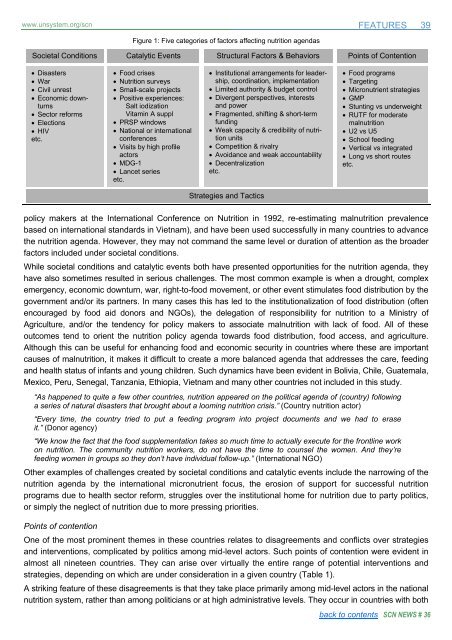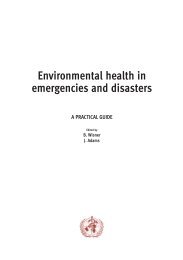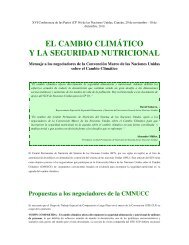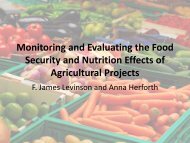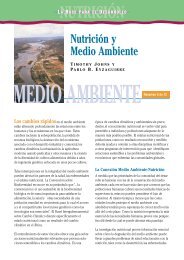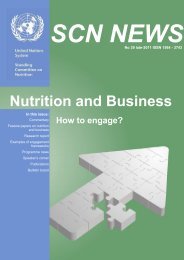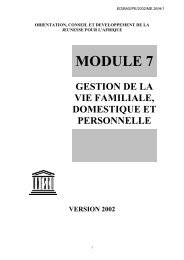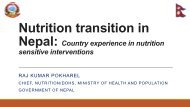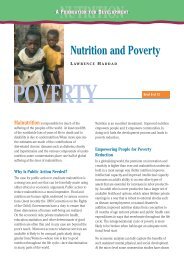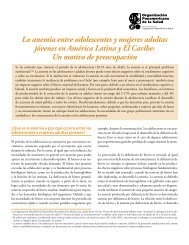SCN News No 36 - UNSCN
SCN News No 36 - UNSCN
SCN News No 36 - UNSCN
Create successful ePaper yourself
Turn your PDF publications into a flip-book with our unique Google optimized e-Paper software.
www.unsystem.org/scn FEATURES 39<br />
Figure 1: Five categories of factors affecting nutrition agendas<br />
Societal Conditions Catalytic Events Structural Factors & Behaviors Points of Contention<br />
• Disasters<br />
• War<br />
• Civil unrest<br />
• Economic downturns<br />
• Sector reforms<br />
• Elections<br />
• HIV<br />
etc.<br />
• Food crises<br />
• Nutrition surveys<br />
• Small-scale projects<br />
• Positive experiences:<br />
Salt iodization<br />
Vitamin A suppl<br />
• PRSP windows<br />
• National or international<br />
conferences<br />
• Visits by high profile<br />
actors<br />
• MDG-1<br />
• Lancet series<br />
etc.<br />
• Institutional arrangements for leadership,<br />
coordination, implementation<br />
• Limited authority & budget control<br />
• Divergent perspectives, interests<br />
and power<br />
• Fragmented, shifting & short-term<br />
funding<br />
• Weak capacity & credibility of nutrition<br />
units<br />
• Competition & rivalry<br />
• Avoidance and weak accountability<br />
• Decentralization<br />
etc.<br />
• Food programs<br />
• Targeting<br />
• Micronutrient strategies<br />
• GMP<br />
• Stunting vs underweight<br />
• RUTF for moderate<br />
malnutrition<br />
• U2 vs U5<br />
• School feeding<br />
• Vertical vs integrated<br />
• Long vs short routes<br />
etc.<br />
Strategies and Tactics<br />
policy makers at the International Conference on Nutrition in 1992, re-estimating malnutrition prevalence<br />
based on international standards in Vietnam), and have been used successfully in many countries to advance<br />
the nutrition agenda. However, they may not command the same level or duration of attention as the broader<br />
factors included under societal conditions.<br />
While societal conditions and catalytic events both have presented opportunities for the nutrition agenda, they<br />
have also sometimes resulted in serious challenges. The most common example is when a drought, complex<br />
emergency, economic downturn, war, right-to-food movement, or other event stimulates food distribution by the<br />
government and/or its partners. In many cases this has led to the institutionalization of food distribution (often<br />
encouraged by food aid donors and NGOs), the delegation of responsibility for nutrition to a Ministry of<br />
Agriculture, and/or the tendency for policy makers to associate malnutrition with lack of food. All of these<br />
outcomes tend to orient the nutrition policy agenda towards food distribution, food access, and agriculture.<br />
Although this can be useful for enhancing food and economic security in countries where these are important<br />
causes of malnutrition, it makes it difficult to create a more balanced agenda that addresses the care, feeding<br />
and health status of infants and young children. Such dynamics have been evident in Bolivia, Chile, Guatemala,<br />
Mexico, Peru, Senegal, Tanzania, Ethiopia, Vietnam and many other countries not included in this study.<br />
“As happened to quite a few other countries, nutrition appeared on the political agenda of (country) following<br />
a series of natural disasters that brought about a looming nutrition crisis.” (Country nutrition actor)<br />
“Every time, the country tried to put a feeding program into project documents and we had to erase<br />
it.” (Donor agency)<br />
“We know the fact that the food supplementation takes so much time to actually execute for the frontline work<br />
on nutrition. The community nutrition workers, do not have the time to counsel the women. And they’re<br />
feeding women in groups so they don’t have individual follow-up.” (International NGO)<br />
Other examples of challenges created by societal conditions and catalytic events include the narrowing of the<br />
nutrition agenda by the international micronutrient focus, the erosion of support for successful nutrition<br />
programs due to health sector reform, struggles over the institutional home for nutrition due to party politics,<br />
or simply the neglect of nutrition due to more pressing priorities.<br />
Points of contention<br />
One of the most prominent themes in these countries relates to disagreements and conflicts over strategies<br />
and interventions, complicated by politics among mid-level actors. Such points of contention were evident in<br />
almost all nineteen countries. They can arise over virtually the entire range of potential interventions and<br />
strategies, depending on which are under consideration in a given country (Table 1).<br />
A striking feature of these disagreements is that they take place primarily among mid-level actors in the national<br />
nutrition system, rather than among politicians or at high administrative levels. They occur in countries with both<br />
back to contents <strong>SCN</strong> NEWS # <strong>36</strong>


